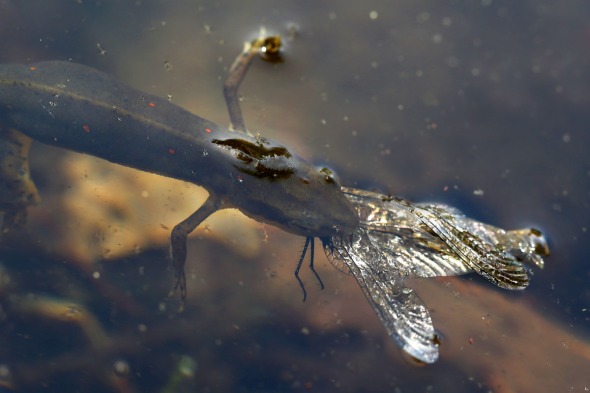Damselflies & Dragonflies Eclosing
 It’s time to check emerging vegetation along the shores of ponds for adult damselflies and dragonflies emerging from their larval skins (eclosing). Fully developed aquatic larvae crawl up out of the water onto emergent vegetation and rocks, split the back of their skin and emerge as winged adults.
It’s time to check emerging vegetation along the shores of ponds for adult damselflies and dragonflies emerging from their larval skins (eclosing). Fully developed aquatic larvae crawl up out of the water onto emergent vegetation and rocks, split the back of their skin and emerge as winged adults.
As the adult slowly pulls itself up and out of its larval skin two things are immediately apparent. Newly eclosed dragonflies and damselflies lack pigment, and they are extremely vulnerable to predation as they hang clutching their old skin, pumping air into their body and liquid into their expanding wings. These newly-eclosed adults must wait in this position, unable to escape predators, until their wings dry and they can fly. (Photo: damselfly eclosing. Note diminutive size of cream-colored wings before they expand.)
Naturally Curious is supported by donations. If you choose to contribute, you may go to http://www.naturallycuriouswithmaryholland.wordpress.com and click on the yellow “donate” button.
Newly-emerged Dragonflies Vulnerable
 When a dragonfly larva crawls up out of the water onto emergent vegetation or a rock to split its skin and emerge as a winged adult, it is in its most vulnerable state, for until its wings are pumped up and dry, it is incapable of flying.
When a dragonfly larva crawls up out of the water onto emergent vegetation or a rock to split its skin and emerge as a winged adult, it is in its most vulnerable state, for until its wings are pumped up and dry, it is incapable of flying.
Often for two or three hours a newly-emerged dragonfly will cling to the substrate, pumping hemolymph into its wings until they are fully expanded and then hang there defenseless while its exoskeleton and wings begin to harden. Only then does pigment in the dragonfly’s body become apparent, and its formerly pale, colorless head, thorax, abdomen and wings (see inset) assume their true colors.
The pictured Common Grackle has taken advantage of this precarious stage in a dragonfly’s life cycle and collected several dragonflies to feed to its offspring. The dragonflies’ lack of color indicates that this predation took place while the dragonflies were still flightless and before pigmentation was present.
Naturally Curious is supported by donations. If you choose to contribute, you may go to https://naturallycuriouswithmaryholland.wordpress.com and click on the yellow “donate” button.
Dragonfly Eclosure: A Vulnerable Time
 Dragonfly larvae reside in ponds until the time comes for them to climb up stalks of emergent vegetation or adjacent rocks, split their larval skin and emerge as adults (a process called eclosure). Before it can take flight, a dragonfly has to cling to the substrate long enough to expand its wings by pumping fluid into them, and dry its exoskeleton as well as its wings. During this time the dragonfly is extremely vulnerable – not only can it not fly, but it is usually situated directly above the water. The slightest breeze can blow it from its precarious perch into the water below, where opportunistic predators such as this Eastern Newt are at the ready and make quick work of their helpless prey.
Dragonfly larvae reside in ponds until the time comes for them to climb up stalks of emergent vegetation or adjacent rocks, split their larval skin and emerge as adults (a process called eclosure). Before it can take flight, a dragonfly has to cling to the substrate long enough to expand its wings by pumping fluid into them, and dry its exoskeleton as well as its wings. During this time the dragonfly is extremely vulnerable – not only can it not fly, but it is usually situated directly above the water. The slightest breeze can blow it from its precarious perch into the water below, where opportunistic predators such as this Eastern Newt are at the ready and make quick work of their helpless prey.
Naturally Curious is supported by donations. If you choose to contribute, you may go to http://www.naturallycuriouswithmaryholland.wordpress.com and click on the yellow “donate” button.


















What Other Naturally Curious People Are Saying